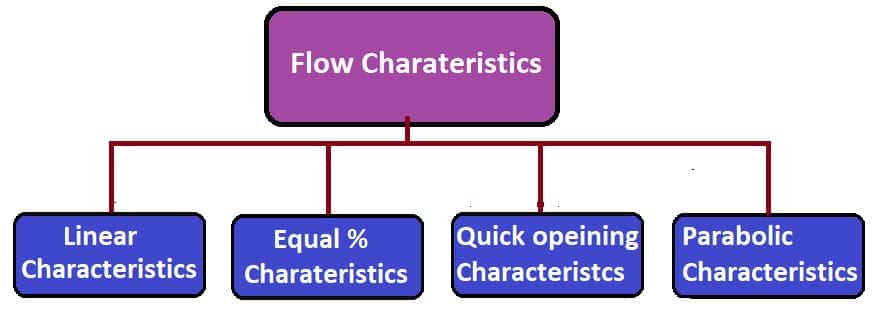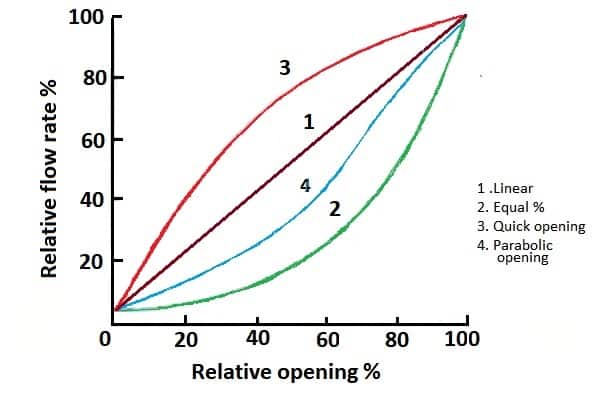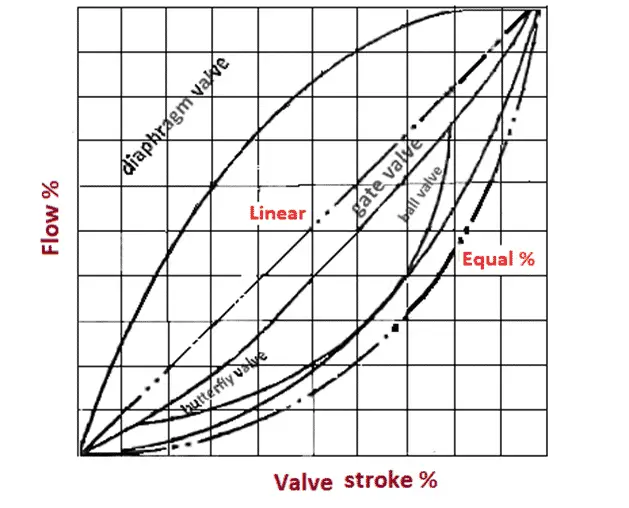Control valve flow characteristic shows the relationship between the relative flows of the process media flowing through the control valve and valve opening. It’s opening under the condition of constant pressure difference at both ends of the valve.
“Flow characteristic” is a general term and should always designate either the inherent characteristic of the flow or that of the flow with the valve installed. The inherent characteristic of the flow is that produced with a constant pressure drop across the valve.
The flow characteristic is an important technical index and parameter of the control valve. Important in making the correct selection in the control valve application.
Generally, the flow characteristic of the valve can be divided into linear characteristic, equal percentage characteristic (logarithm), parabola characteristic, and Quick opening characteristic relative opening.

Linear Characteristic
It refers to the linear relationship between the relative flow and the relative opening of the valve. It is the change in flow caused by the change in the opening of the valve that is constant. The relative stroke of the linear characteristic and the relative flow is perfectly in a linear relationship.
The change of flow caused by the valve stroke change is constant. When the flow rate is large, the relative flow value changes little. When the flow rate is small, the relative flow value changes a lot.

The Equal Percentage (logarithm) Characteristic
It means that the relative flow change caused by the change in valve opening is proportional to the relative flow at this point. That is the amplification factor of the control valve changes and increases with increased flow.
The relative stroke and the relative flow of features are of equal percentage, not linear.
At each point in the stroke, the flow change caused by the change in unit stroke is proportional to the flow at this point, and the change in percentage inflow is equal.
Therefore, its advantage is that when the flow rate is small, the flow rate changes little. When the flow rate is large, the flow rate changes a lot. That is, at different degrees of valve opening, it has the same regulating precision.
Parabolic Characteristic
It means that the relative flow change caused by the change in the relative aperture of the valve is proportional to the square root of the relative flow value at this point.
The flow rate changes in proportion to the square of the valve stroke. Parabolic characteristics generally have an intermediate characteristic between linear and equal percentage characteristics.
Quick Opening Flow Characteristic
It means that there is a higher flow rate when the valve opening is small. With the increase of the opening, the flow rate can reach the maximum quickly. And, then the closing increases, the flow change is small. Therefore, this is a quick-open feature.
Valve Flow Characteristics

We can see from the above figure the flow characteristics of various types of valves. The Diaphragm valve has a flow characteristic close to the quick-opening characteristic. The butterfly valve has flow characteristics close to the equal percentage characteristic. The flow characteristic of the gate valve is linear.
The ball valve’s flow rate is linear at the final opening and closing, and an equal percentage characteristic at mid-opening.
Various Valves – Flow Characteristics
Under normal circumstances, the ball valve and butterfly valve are generally most suitable for regulation when the opening is small. They are fast opening, and we use these valves for making the adjustments.
Most of the valves used for regulation are basically globe valves.
Machining of the molding in parabolic, conical, spherical, etc. and it will have different curve characteristics. Generally speaking, the equal percentage characteristic is used more for regulation.
Read Next: